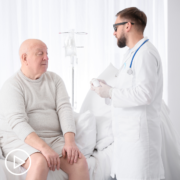How Can We Improve Remote Access for Prostate Cancer Patients?
How Can We Improve Remote Access for Prostate Cancer Patients? from Patient Empowerment Network on Vimeo.
How can prostate cancer remote access and care be improved for patients? Dr. Heather Cheng from Seattle Cancer Care Alliance shares how optimal remote care can be ensured and explains some situations when in-person care can provide better care.
See More from Prostate Cancer TelemEDucation
Related Programs:

Should Prostate Cancer Patients and Families Keep Using Telemedicine? |

|

|
Transcript:
Sherea Cary:
It sounds like to me that telemedicine is similar to the work from home, and it seems like we’re all getting benefits from the ability to be able to do some things in a remote fashion. Are there any steps being taken to improve remote access for prostate cancer patients?
Dr. Heather Cheng:
Yeah, I think…I don’t know that the efforts that we have are specific to prostate cancer patients, but I sure hope that prostate cancer patients, like all of our patients across medicine can continue to benefit from these new technologies, and I think we are getting better…we’re not perfect, of course, there’s always room for improvement, but we’re getting better at trying to partner with our patients to figure out how to do this in a way that is as optimal as possible, and sometimes I think there is great value still to seeing people face to face and examining them, and sometimes that can’t really be replaced, but maybe that’s not all the time for all the visits, and so as long as patients are comfortable using the platform, using the telemedicine, using the software and the phone, those things, some patients aren’t. So, I think we need to really make sure that the patients who are not comfortable or who need a little extra help with the technology get the help they need so that they are not left behind. Because I do worry a little bit about people who may be not as comfortable with using video conference or ZOOM or things that many of us are getting more familiar with, but not all patients are, so we need to just make sure we’re thinking about those of those who may not be quite as comfortable or maybe whose Internet access is not as stable, things like that.










